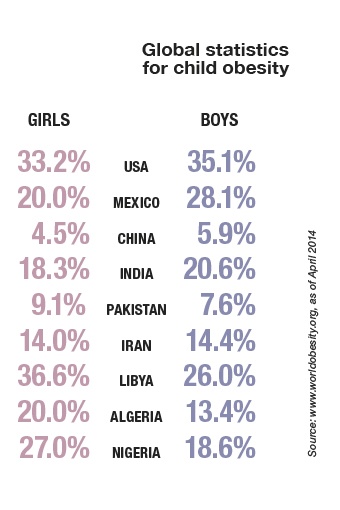
Baby fat is important – but when does it stop being a question of normal puppy fat and start becoming a battle against excess weight? It is striking that even the very young are now struggling with excess weight in their day-to-day lives with increasing frequency. Statistics show that as many as 22 per cent of seven to eleven year olds in Switzerland are overweight. A north-south divide has been identified in Europe (see diagram). In Italy for instance, 36 per cent of this age group are considered overweight – in Germany the figure is just 16 per cent.
There are similar statistics from other continents. In Mexico, 28 per cent of boys suffer from obesity; in Libya it is 26 per cent and in India 21 per cent. Even China, at 6 per cent, is seeing rising numbers of obese boys. Obesity increases the risk of diabetes, skeletal deformation as well as heart and circulatory disease. It is for this reason that the WHO (World Health Organisation) has described child obesity as a global problem.
These are the circumstances under which the “Early Nutrition” research project was launched. Its objective is to research the nutritional habits of young children from birth for the first 1,000 days of life. Some important connections have already been established in the time since the project’s inception in 2012. We now know that the human metabolism is largely shaped and developed during pregnancy and the first two years of life. This makes it subject to external influences in the first 1,000 days – either by breastfeeding or by using appropriate – or inappropriate – formula for infants and toddlers.
"EarlyNutrition" research project
With EU support, scientists from twelve member states as well as Norway, the USA and Australia are investigating nutritional tendencies affecting the first 1,000 days of a child’s life i.e. from conception to the end of the child’s second year. For more information, go to www.project-earlynutrition.eu
The possibility of change
Given this context, the “Early Nutrition” project is looking both at factors that affect mothers during pregnancy such as lifestyle, diet and body mass and also considering the mechanisms that determine nutrition in the early years. The objective is to find ways of avoiding negative influences on the child. One solution is to prevent excessive weight gain in children in the first two years of life. Otherwise the metabolism grows accustomed to a high energy intake during this period and develops a false feeling of hunger. Preventive measures such as breastfeeding are far more effective than attempting to change the metabolism at a later stage.
Guidance on research, development and marketing
The results of the “Early Nutrition” project and the global knowledge transfer related to it are influencing the development of nutrition during pregnancy as well as the development of infant formula and foods for small children and young persons. Our research and development department is drawing on this scientific evidence and we place great store on attending international symposia and maintaining links with the research industry. Nutritional experts now believe that our industry’s products can have a far more positive influence on programming the metabolism than previously thought.
Nutritional experts now believe that our industry’s products can have a far more positive influence on programming the metabolism than previously thought.
Infant formula – maintaining a balance between calories and nutrition
We are seeking to ensure that both mother and child receive the right food at the right time. In developing infant formula this currently means developing formulations with high-quality protein. With the exception of special milks, our HOCHDORF infant formula and follow-on milks destined for the EU market are already low in fat-producing proteins and the protein is of the very highest quality.
Milk products for juniors and mothers combat poor nutrition
Across the globe many children have a diet that is too rich in energy and too lacking in vitamins.
The traditional high-protein, high-fat cow’s milk does not offer the best solution for every child. And standard low-fat milk has the drawback that it fails to meet children’s nutritional requirements in regions where the diet is one-dimensional.
This explains the growing importance of junior milk: it serves as a supplement in countries where there is a nutritional need. The iron, vitamin A, vitamin D, iodine and special fatty acids contained in junior milk are important elements in the mental and physical development of infants and young children. Whereas children’s diets often contain too much protein and too few high-quality fats and vitamins traditionally, junior milks can even be adapted to regional circumstances.
The same applies to milk products for expectant and breastfeeding mothers. During pregnancy, expectant mothers have greater energy and vitamin requirements. The additional calorie intake should be of a high quality so that the infant metabolism maintains its correct balance. Unlike the nutritional supplements commonly available on the market, milks for expectant and breastfeeding mothers are subject to the same strict regulations as infant and junior formulae. In addition to high-quality vitamins and minerals, In addition to high-quality vitamins and minerals, they contain healthy fibre and valuable lactose instead of sugar.
Increasing regionalisation of products for infants and mothers
We all live in an environment that significantly affects our diet and therefore our metabolism. Research results from the “Early Nutrition” project show that milk products for mothers and infants are not available to everyone. Regional adjustments to formulations will become more common in the future. We therefore aim to tailor our products to specific needs and this means taking geographical and physiological differences regarding nutrition into account.
Facts and figures on obesity



Conclusion
There are two important points to bear in mind. First, by following a balanced diet an expectant mother gives her child the best possible start in life. Second, the baby should avoid excessive weight gain in the first two years of its life. The basis for this is a balanced diet where an appropriate range of foods is available.
If parents choose to use infant formula and milk products for expectant and breastfeeding mothers, our products support these two important areas for the baby’s development – and thanks to current research we can do this even more effectively.
Further Information
- Interview with Dr. med. J. Spalinger talking about the "increasing obesity among babies and young children"










Leave a comment